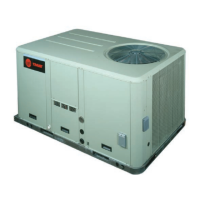Sequence of Operation
66 RT-SVX21AC-EN
Supply Air Temperature Reset
The supply air temperature can be reset by using one of
four DIP switch configurations on the RTAM or through
ICS when a valid supply air reset setpoint with a supply air
reset amount is given. A selectable reset amount of 0° F to
20°F via RTAM potentiometer or ICS is permissible for
each type of reset.
The amount of change applied to the supply air
temp
erature setpoint depends on how far the return air,
zone, or outdoor air temperature falls below the reset
temperature setpoint. If the return air, zone, or outdoor air
temperature is equal to or greater than the reset
temperature setpoint, the amount of change is zero.
If the return air, or zone tem
perature falls 3°F below the
reset temperature setpoint, the amount of reset applied to
the supply air temperature will equal the maximum
amount of reset selected.
If the outdoor air temperature falls
20°F below th
e reset
temperature setpoint, the amount of reset applied to the
supply air temperature will equal the maximum amount of
reset selected. The four DIP switch configurations are as
follows:
1. None - When RTAM DIP Switch #3 and #4 are in the
“Off
” position, no reset will be al
lowed.
2. Reset based on Return Air Temperature - When RTAM
DIP Switch #3 is
“Off” and Switch #4 is “On”, a
selectable supply air reset setpoint of 50°F to 90°F via
a unit mounted potentiometer or Tracer® is
permissible.
3. Reset based on Zone Temperature - When RTAM DIP
Switch
#3 is “On” and Switch #4 is “Off”, a selectable
supply air reset setpoint of 50°F to 90°F via RTAM
potentiometer or Tracer® is permissible.
4. Reset based on Outdoor Air Temperature - When DIP
Switch #
3 and #4 are
“On”, a selectable supply air reset
setpoint of 0°F to 100°F via RTAM potentiometer or
Tracer® is permissible.
Return Air Smoke Detector
The return air smoke detector is designed to shut off the
unit if smoke is sensed in the return air stream. Sampling
the airflow entering the unit at the return air opening
performs this function.
In order for the smoke detector to properly sense smoke in
the
return air stream, th
e air velocity entering the unit must
be between 500 and 4000 feet per minute. Equipment
covered in this manual will develop an airflow velocity that
falls within these limits over the entire airflow range
specified in the evaporator fan performance tables.
There are certain models however, if operated at low
a
irflow, will not develop an airflow velocity that falls within
the required 500 to 4000 feet per minute range. For these
models, the design airflow shall be greater than or equal
to the minimum CFM specified in the table provided
below. Failure to follow these instructions will prevent the
smoke detector from performing its design function.
Economizer Start-Up
Minimum Position Setting for 17 Plus, 6 to 10
Ton with Multi-Speed, or Single Zone VAV
1. Apply power to the unit.
2. Using the Service Test Guide on unit access panel,
momenta
rily jump across the Test 1 and Test 2
terminals on LTB1 one time to start indoor fan.
3. Turn the MIN POS - DCV potentiometer on
the RTEM
clockwise to open or counter-clockwise to close. The
d
amper will open to this setting for low speed fan
operation. When adjusting minimum position, the
damper may move to the new setting in several small
steps. Wait at least 15 seconds for the damper to settle
at the new position. Range of damper for this setting is
0-100%.
4. Momentarily jump across the Test 1 and Test 2
terminals
on LTB1, to cycle through test modes to Cool
1.
5. Turn the DCV SETPOINT -
LL potentiometer on the
RTEM
clockwise to open or counter-clockwise to close.
This will set the minimum damper position at an
intermediate point of fan operation range of damper
for this setting is 0-75%.
6. Momentarily jump across the Test 1 and Test 2
terminals
on LTB1, to cycle through
test modes to Cool
2.
7. Turn the MIN POS - DESIGN
potentio
meter on the
RTEM clockwise to open or counter-clockwise to close.
This will set the minimum damper position at
maximum fan speed. Range of damper for this setting
is 0-50%.
8. The economizer minimum damper position for all fan
speeds is
comp
lete. The RTEM will control minimum
damper position along an imaginary line between the
3 damper minimum positions based on fan speed.
Note: The RTEM will limit intermediate minimum
damper position to ensure proper ventilation based
upon the low fan speed minimum damper position set
in Step 3.
9. Replace the filter access panel. The damper will close
wh
en the bl
ower circuit is de-energized.
WARNING
Live Electrical Components!
Failure to follow all electrical safety precautions when
exposed to live electrical components could result in
death or serious injury. When necessary to work with
live electrical components, have a qualified licensed
electrician or other individual who has been properly
trained in handling live electrical components perform
these tasks.

